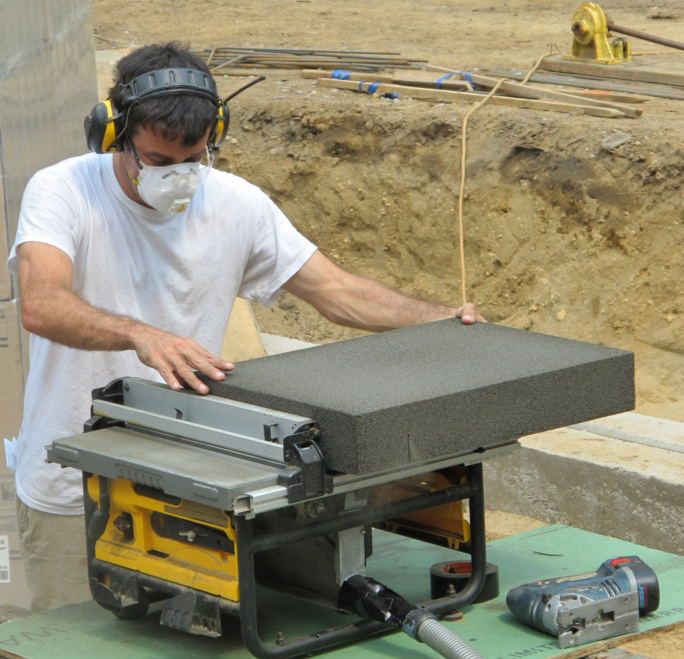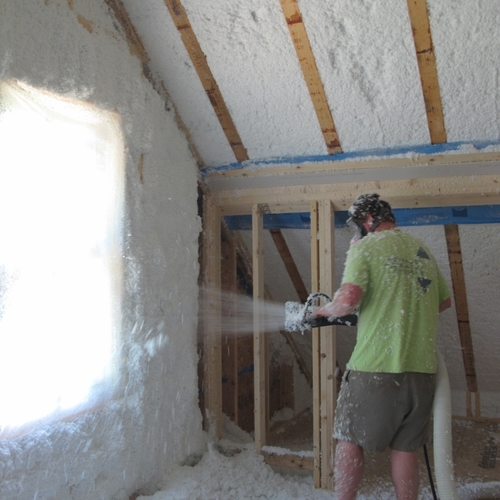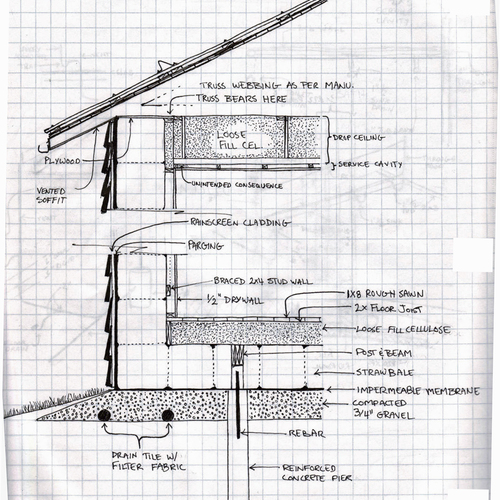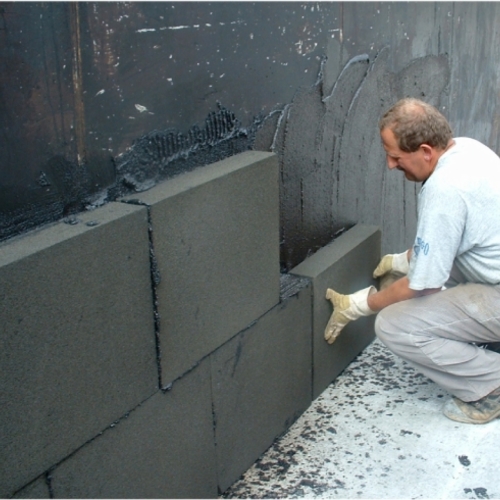
Image Credit: Alex Wilson
Image Credit: Alex Wilson We installed 4-inch-thick Foamglas as sub-slab insulation.
Image Credit: Alex Wilson The Foamglas was laid on sand, which was installed over a geotextile on top of a 4-inch bed of crushed stone, with a standpipe should radon mitigation be required.
Image Credit: Alex Wilson In this photo you can sort-of see the cellular structure of the rigid material.
Image Credit: Alex Wilson We installed 6-inch Foamglas blocks on the exterior foundation walls using a polymer-cement adhesive.
Image Credit: Alex Wilson A photo showing the Foamglas nearly to the final height. We actually ran the Foamglas midway up the rim joists (after installing a barrier product).
Image Credit: Alex Wilson Mixing the Ardicoat waterproofing material — an acrylic gets mixed with a proprietary mix of Type I and Type II portland cement.
Image Credit: Alex Wilson A layer of polypropylene mesh gets embedded into the Ardicoat for strength and flexibility.
Image Credit: Alex Wilson Using a crane to put the 200-year-old house back onto the completed foundation.
Image Credit: Alex Wilson
In my role with Environmental Building News and our GreenSpec Product Database, I get plenty of opportunities to research and write about innovative building products. That’s one of the really fun aspects of my job.
On occasion I also get an opportunity to try out new or little-known materials. In the construction of our new home in Dummerston, Vermont — actually the rebuilding of a 200-year Cape — I’ve had opportunity to get some real experience with lots of products. One of these is a cellular glass insulation material known as Foamglas.
Why we need a product like Foamglas
I’ve written often about the problems with extruded polystyrene from an environmental and health perspective. Relative to performance, extruded polystyrene (XPS) is a great product. It is water-resistant so can be used below-grade; it has high compressive strength so can be used beneath a concrete slab floor; it insulates very well (R-5 per inch); and it’s inexpensive. These properties make XPS the nearly universal choice for sub-slab and exterior foundation insulation today.
But along with these benefits are some significant downsides. All XPS today (as well as expanded polystyrene, EPS) is made with the brominated flame retardant HBCD that has recently been added to the Stockholm list of Persistent Organic Pollutants (POPs) and is being banned in much of the world. HBCD provides some level of fire protection, though some studies suggest that its benefits are greatly exaggerated — and that that protection, if real, is irrelevant below grade.
In addition, XPS is currently made with the blowing agent HFC-134a, which is a potent greenhouse gas that contributes to global warming. And some of the petrochemical-derived raw materials, including benzene and styrene monomer, are carcinogenic — though once converted into polystyrene, that carcinogenicity is not present.
From a performance standpoint, XPS — like most other foam plastic insulation materials — is readily tunneled through by subterranean termites, carpenter ants, and other wood-boring insects.
Foamglas to the rescue
Foamglas is a cellular glass, rigid boardstock insulation material. It has high compressive strength, excellent moisture resistance, and tremendous fire resistance without the use of flame retardants. It is moderately well-insulating at R-3.4 per inch (32% lower than XPS), and it’s made without environmentally damaging blowing agents. It is also about the only insulation material that is totally impervious to wood-boring insects — a useful property for below-grade applications — particularly in a warming planet with termites extending their ranges north.
Foamglas has actually been around a long time — since Pittsburgh Corning introduced it in the 1930s — but it is used primarily for high-temperature industrial applications, such as insulating steam pipes and furnaces. It’s use as an insulation material for buildings remains very uncommon, though this use is increasing in Europe.
Even though Foamglas is significantly more expensive than XPS and its per-inch insulating value is lower, the environmental and health benefits made me want to try it out on our own home.
Stone veneer cement makes a good adhesive
We installed four inches of Foamglas under the basement floor slab and six inches on the exterior of the foundation walls. Our designer/builder, Eli Gould, and his six-person crew not only did admirably with this little-known material, but he came up with what I believe is a great option for adhering Foamglas to a foundation wall.
We were debating whether to use Pittsburgh Corning’s recommended solvent-based adhesive (“tar”) or their acrylic formula (a greener, water-based tar), which apparently doesn’t have quite as good performance properties as the solvent-based option. But the recommended solvent-based formulation sounded quite hazardous (it’s a two-component adhesive with one component consisting of three different types of diisocyanate and the other component consisting of petroleum asphalt, coal bitumen, naphthenic distillate, and hydrocarbon solvents). We wanted a well-performing adhesive, but the solvent-based option didn’t sound like something we wanted to expose workers to during installation or surround our home with.
Eli tested different engineered cement products, as modern polymers have dramatically changed the adhesive capabilities of cement in the last couple decades. They are also free of VOCs and sounded far safer from a health and environmental standpoint.
We settled on a polymer cement product made by Ardex used for adhering stone veneer onto masonry walls, and it worked beautifully. The two companies (Ardex and Pittsburgh Corning) were so intrigued by our field-testing that they have begun conversations about testing and developing this alternative adhesive system.
Ardex also supplies a waterproofing coating that we applied over the Foamglas on the foundation walls: Ardicoat Plus. We used this in place of conventional asphalt-based (tar) coating, and I feel really good about not having hydrocarbons from the coating seeping into the groundwater or being released as VOCs.
Compared to XPS, it costs more and has a lower R-value
Our foundation ends up with a respectable R-12 under the basement slab and R-22 on the exterior of the foundation walls. That’s not up to the insulation levels in a typical Passivhaus, but it should be good enough to enable us to achieve net-zero-energy performance with a PV system supplying power for an air-source heat pump. And it should last literally hundreds of years — a lifespan that I believe we should be aiming for in home building today.
We spent more for the Foamglas foundation insulation than we would have with XPS, but it feels good to have put my money where my mouth is relative to spurring product innovation and demonstrating greener building material options.
Eli and I also hope that by leading this sort of collaboration we may be able to help drive down the costs while broadening the market for Foamglas and other innovative products. With Foamglas and other inorganic products like this that may come along, we hope to see more durable, insect-resistant foundation systems that can help reduce energy consumption while minimizing health and environmental impacts.
Foundations are not the only part of the building in which Eli and I plan to help companies “connect the dots” in developing better buildings. We’re working on innovative window solutions for existing homes, superinsulated roof systems, and modular components to speed construction — but those are topics for future columns.
Who knows, maybe we can even convince some leading manufacturers to move to the Brattleboro area and help to spur economic development in the region.
Alex is founder of BuildingGreen, Inc. and executive editor of Environmental Building News. He also recently created the Resilient Design Institute. To keep up with Alex’s latest articles and musings, you can sign up for his Twitter feed.
Weekly Newsletter
Get building science and energy efficiency advice, plus special offers, in your inbox.














18 Comments
Foamglass and mineral wool
Hi Alex-
I applaud you on finding an innovative way to use a product that reduces the amount of XPS in your home. Did you consider using a mineral wool product? I believe Roxul makes a below-grade product with an R-value of 4.3/inch. I'm curious how such products would stack up against Foamglass in the ways you compared it with XPS.
I'm in the planning stages of my own new home and, like you, I'd prefer to avoid rigid (and spray) foam where other suitable products exist.
Good luck on the rest of your project.
Peter
vs. rigid mineral wool
Peter,
Yes, I did consider rigid mineral wool and would have used it had I not been able to get the Foamglas. Roxul has tested the use of their TopRock product for sub-slab, but as far as I know the company is not yet willing to recommend it (though that wouldn't have stopped me). Roxul TopRock would be more affordable--but I really wanted to try out Foamglas, since I've been writing about it for several years.
workability?
how is the foam glass to work w/? crumbly? pretty tough? when you saw it, are glass shards blowing about so you'd want to do that outside? looks like an interesting product.
Useful blog, and yes tell us
Useful blog. Pictures show install well.
As to your home lasting centuries, your joist system IMO will not. Choose timber framing for centuries and solid sawn for decades and OSB for Rot.
Mineral Wool
Hi Alex-
Roxul has a product named DrainBoard:
http://www.roxul.com/building+envelope/products/roxul+drainboard®
That is intended for below grade. It's unclear if it's intended for sub-slab but I'm considering this in place of XPS below our slab. Maybe this wasn't available when you were looking at Roxul product?
Roxul drainboard and cutting Foamglas
Yes, Drainboard was available, but I think the TopRock product has an even greater density, so would be preferred for sub-slab.
Relative to cutting Foamglas, we used a jobsite table saw with a standard, cheap masonry blade--and it cut like butter. Eli does have a simple vacuum dust collection system, which was helpful.
The material is brittle and somewhat friable, but at a 4" thickness we didn't have much problem with breakage in walking on it. On a foundation wall, you can push it in and it dents where there are bumps in the concrete. Once they got used to it, Eli's crew liked it pretty well.
I'll cover open-web trusses in a future blog, Robert. You might like the ones we used.
Robert may like, aj and Joe not so much...
Robert may like, aj and Joe L. not so much... I do like the fact that you did choose the non OSB type truss joists though your rim joist is OSB and is, as anyone who has replaced rim joists... at a vulnerable location in a home.
Foamglas / Mineral Wool
Peter,
Regarding sub-slab insulation and compressive strength, there is an order of magnitude difference between foamglas and mineral wool (rigid board insulation).
Roxul's highest density product, Toprock, is rated at 11 psi (at 10% compression). Current Foamglas slabs are rated >100 psi compressive strength.
http://www.roxul.com/building+envelope/products/roxul+toprock%C2%AE+dd
http://www.foamglas.us/building/products/product_overview/foamglas_slabs
Based on these figures, high density rigid mineral wool insulation can easily handle the dead load of a 4-6" concrete slab. But what about dynamic loads? Or compression rates? Or long term material creep/deformation? So far, the major manufacturers---Roxul and Thermafiber---have not approved any of their products for use in a sub-slab application. Below grade, yes. Sub-slab, no.
____________
Alex,
Thanks for the great description and pictures!
Foamglass and mineral wool
Hi Daniel-
Thanks for raising the issue of dynamic load and creep. I suspect if Roxul thought their current product could meet another application, they would be touting it for just such an application. The fact that they don't recommend it for sub-slab says all I need to hear.
Peter
Foamglas Sulfur Smell
I've tried some Foamglas and it has a very strong sulfur smell when handled and cut. I'm concerned that this apparent outgassing of sulfur could be a problem when used for interior applications (health, and corrosion [like Chinese drywall]). Is this an issue, and does this limit it to applications where it is on the exterior or covered by a slab?
Sulfur in Foamglas
Adam,
I am told that the cells in Foamglas contain about 0.5% hydrogen sulfide, which produces the characteristic "rotten-egg" smell when cut or scratched. This is a product of the way the material is manufactured. Hydrogen sulfide is hazardous at high concentrations, so this isn't a gas we want to be breathing a lot of, but I am confident that such a tiny amount will be escaping that there is no need for concern. I believe this, because I have heard that Foamglas removed from buildings after 40 or 50 years will still produce the hydrogen sulfide smell--which indicates that the vast majority of the gasses in the cellular structure remain in place. Even though I am only using Foamglas in applications separated from the living space by concrete, I would have no concern about using it in an indoor application.
Cost
Whatt is the cost difference of Foamglas compared to XPS or Top Rock? Can you at least give a range of order - 50% more, twice as much, ten times as much? Also even though you note your builder and his crew learned how to efficiently install it, I'm sure it was most costly than an XPS installation. I think it is important to share this information to get the full picture of the choice to use this product.
Roxul experience
As a green builder of many years, I am always looking for ways to reduce or eliminate the use of rigid foam products. I have used Roxul Drainboard for foundations and have been pleased with it & do not mind paying a little more for an environmentally cleaner product. I am currently retrofitting my own older home foundation walls with Roxul. I was hoping Roxul's Top Rock would eventually be approved for subslab applications.
In this light, I am pleased to know of the Foamglass product & will investigate.
Thanks Alex, for blazing the trail once again!
Price of Foamglas
Doug,
A very fair question! The MSRP (manufacturer's suggested retail price) for Foamglas is $1.68 per board foot, and the company told me that average contractor discounting is about 30% (though highly variable), which would bring it down to about $1.18/bf. I purchased it for significantly less than that, but know that I got a particularly good deal from Pittsburgh Corning. They also paid for shipping.
I believe that Foamglas can be purchased for about $1.00/bf, which was the contractor price I mentioned in a 2010 product review in EBN. In comparing this to XPS, you have to remember that the R-value for Foamglas is lower. My local pricing for Dow Styrofoam, when I quoted it last summer, was $0.59/bf. With this pricing--$1.00/bf for R-3.4 (Foamglas) vs. $0.59/bf for R-5 (Styrofoam)--Foamglas is 2.5 times the cost of Styrofoam for the same R-value.
An example
Using Alex's cost of $1 per board foot, let's look at a hypothetical example.
What would it cost to insulate a 26 ft. by 32 ft. foundation to the R-values that Alex specified?
The slab measures 832 sq. ft., so 4 inches of Foamglas requires 3,328 board feet.
There are 116 linear feet of wall. If the walls are insulated to a height of 8 feet, that's 928 square feet of wall insulation. If you insulate with 6 inches of Foamglas, that means that you need 5,568 board feet for the walls.
Add up the total board feet: 3,328 (slab) + 5,569 (walls) = 8,896 board feet.
So that comes to $8,896 of Foamglas, before shipping.
Is there ANY way to purchase foamglas boards today in the US? I realize they took it off the residential market but still sell it for commercial purposes. If I call up their number for commercial/industrial sales of Foamglas boards will they sell it to me? I see it readily available online in the UK for anyone to purchase there..
Hi David,
I have no idea about Owens Corning, but you might also contact the Vermont startup "Glavel". They should be bringing foam-glass materials to market in the near(?) future, and list a board material ("Glapor") alongside foam-glass aggregate: https://www.glavel.com/products/
Thanks Karl. I've emailed them inquiring about the Glapor boards.
Log in or create an account to post a comment.
Sign up Log in